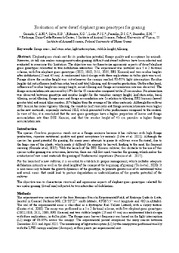Evaluation of new dwarf elephant grass genotypes for grazing.
Evaluation of new dwarf elephant grass genotypes for grazing.
Author(s): GOMIDE, C. A. de M.; SILVA, R. B.; RIBEIRO, K. G.; LEDO, F. J. da S.; PACIULLO, D. S. C.; BARRADAS, E. M.
Summary: Elephant grass stands out for its production potential, forage quality and acceptance by animals. However, its tall size makes management under grazing difficult and dwarf cultivars have been selected and evaluated to overcome this limitation. The objective was to characterize agronomic aspects of dwarf elephant grass genotypes submitted to two defoliation intensities. The experiment was installed in a 5 x 2 factorial scheme, with five elephant grass genotypes (2022, 1810, 2111, 2035, BRS Kurumi) and two residue heights after defoliation (25 and 45 cm). A randomized block design with three replications in 4x3m plots was used. Forage above the residue height was cut whenever the canopy reached 93-95% light interception. Residue heights did not influence leaf/stem ratio, basal and total tillering, and dry matter production. On the other hand, influence of residue height on canopy height, aerial tillering and forage accumulation rate was observed. The forage accumulation rate increased by 19% for the 45 cm residue compared to the 25 cm residue. No interaction was observed between genotype and residue height for the variables canopy height, leaf:stem ratio, basal tillering, aerial tillering, forage mass and forage accumulation rate. In relation to tillering, BRS kurumi showed greater total and aerial tiller number, 31% higher than the average of the other materials. Although the cultivar BRS kurumi has more vigorous tillering, the variables leaf:stem ratio and forage accumulation rate were higher in the new materials, especially material 1810, which presented better performance compared to the control. In view of this, it is concluded that the new grass genotypes have a higher proportion of leaves and forage accumulation rate than BRS Kurumi, and that the residue height of 45 cm provides a higher forage accumulation rate.
Publication year: 2023
Types of publication: Paper in annals and proceedings
Unit: Embrapa Dairy Cattle
Keywords: Capim Elefante, Caule, Folha, Forragem, Interceptação de luz, Perfilhamento, Planta Forrageira, Tillering
Observation
Some of Embrapa's publications are published as ePub files. To read them, use or download one of the following free software options to your computer or mobile device. Android: Google Play Books; IOS: iBooks; Windows and Linux: Calibre.
Access other publications
Access the Agricultural Research Database (BDPA) to consult Embrapa's full library collection and records.
Visit Embrapa Bookstore to purchase books and other publications sold by Embrapa.

